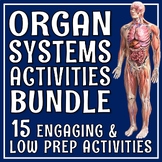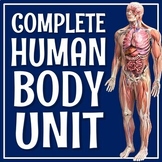Human Body Organ Systems Respiratory System Activity Lung Lab NGSS MS-LS1-3
Flying Colors Science
4.8k Followers
Grade Levels
7th - 10th
Subjects
Resource Type
Standards
NGSSMS-LS1-3
Formats Included
- PDF
- Google Apps™
Pages
3 pages
Flying Colors Science
4.8k Followers

Includes Google Apps™
The Teacher-Author indicated this resource includes assets from Google Workspace (e.g. docs, slides, etc.).
What educators are saying
This assignment was great to use for the students, they were well engaged, and very easy for me to explain and get the students to follow the instructions.
This was awesome, kids had lots of fun. Great, engaging way for students to consider how the respiratory system works, and all other body systems involved.
Also included in
- SAVE $20 off list prices! Includes human body systems activities that are easy on the teacher and fun for kids! Includes 15 FUN, fresh, and thoroughly engaging anatomy activities to supplement your Human Body Systems unit. Teachers will appreciate these resources because:The included lessons are hPrice $39.99Original Price $60.92Save $20.93
- Never search for "something to do tomorrow" ever again! This bundle contains PRINT AND GO lessons, NO PREP activities, LOW PREP labs, and ENGAGING articles to supplement and thoroughly enhance a life science course. Every included resource is easy to implement, standards-based, and high-quality.Price $399.99Original Price $750.85Save $350.86
- SAVE OVER 40% off list prices! This is a complete ACTIVITY-BASED Organ Systems lesson unit. This bundle includes every resource I use to teach and assess NGSS MS-LS1-3. All of the work has been done for you - from start to finish! An included unit plan tells you what to teach and when, so you don'Price $109.00Original Price $186.36Save $77.36
- SAVE OVER 20%! These resources are a DONE FOR YOU solution to teaching the respiratory system! Includes FUN and ENGAGING activities, an introductory presentation in both PPT and Google Slides, and a final check-in quiz.This Bundle Includes:✅ Presentation (with Cloze notes) to introduce the respiraPrice $12.99Original Price $20.98Save $7.99
Description
Two VERY LOW-PREP hands-on respiratory system activities for teaching middle school students about lung capacity and respiration rate! Includes both a printable PDF and a Google Slides version for a paperless lab.
⭐Find this resource in our complete Respiratory System Unit!
In this activity, students will:
- Read a background section about the difference between respiration and cellular respiration
- Determine their own lung capacity
- Measure their own respiration rate before and after physical activity
- Answer analysis questions
⭐ Need an EASY and NO PREP way to teach the respiratory system?
⭐ Try our NO PREP Respiratory System Stations Activity!
Materials: balloons, tape measure (we included a printable one)
Teacher Notes:
- Please note that this resource is NOT editable.
- Answer key included.
NGSS Standards:
- MS-LS1-3
- Science & Engineering Practices: Planning and carrying out investigations; Analyzing and interpreting data
⭐This resource is offered at a discount in our COMPLETE UNIT for this topic!
⭐Includes everything you need to TEACH and ASSESS Human Body Systems!
Total Pages
3 pages
Answer Key
Included
Teaching Duration
N/A
Report this resource to TPT
Reported resources will be reviewed by our team. Report this resource to let us know if this resource violates TPT’s content guidelines.
Standards
to see state-specific standards (only available in the US).
NGSSMS-LS1-3
Use argument supported by evidence for how the body is a system of interacting subsystems composed of groups of cells. Emphasis is on the conceptual understanding that cells form tissues and tissues form organs specialized for particular body functions. Examples could include the interaction of subsystems within a system and the normal functioning of those systems. Assessment does not include the mechanism of one body system independent of others. Assessment is limited to the circulatory, excretory, digestive, respiratory, muscular, and nervous systems.









